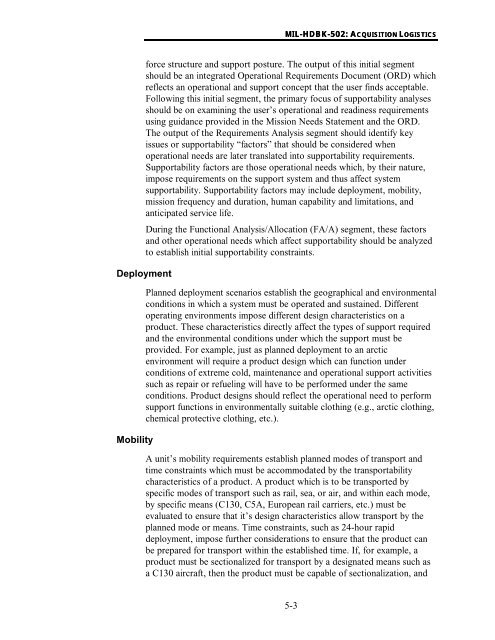MIL-HDBK-502 - Barringer and Associates, Inc.
MIL-HDBK-502 - Barringer and Associates, Inc.
MIL-HDBK-502 - Barringer and Associates, Inc.
Create successful ePaper yourself
Turn your PDF publications into a flip-book with our unique Google optimized e-Paper software.
<strong>MIL</strong>-<strong>HDBK</strong>-<strong>502</strong>: ACQUISITIONALOGISTICSforce structure <strong>and</strong> support posture. The output of this initial segmentshould be an integrated Operational Requirements Document (ORD) whichreflects an operational <strong>and</strong> support concept that the user finds acceptable.Following this initial segment, the primary focus of supportability analysesshould be on examining the user’s operational <strong>and</strong> readiness requirementsusing guidance provided in the Mission Needs Statement <strong>and</strong> the ORD.The output of the Requirements Analysis segment should identify keyissues or supportability “factors” that should be considered whenoperational needs are later translated into supportability requirements.Supportability factors are those operational needs which, by their nature,impose requirements on the support system <strong>and</strong> thus affect systemsupportability. Supportability factors may include deployment, mobility,mission frequency <strong>and</strong> duration, human capability <strong>and</strong> limitations, <strong>and</strong>anticipated service life.During the Functional Analysis/Allocation (FA/A) segment, these factors<strong>and</strong> other operational needs which affect supportability should be analyzedto establish initial supportability constraints.DeploymentMobilityPlanned deployment scenarios establish the geographical <strong>and</strong> environmentalconditions in which a system must be operated <strong>and</strong> sustained. Differentoperating environments impose different design characteristics on aproduct. These characteristics directly affect the types of support required<strong>and</strong> the environmental conditions under which the support must beprovided. For example, just as planned deployment to an arcticenvironment will require a product design which can function underconditions of extreme cold, maintenance <strong>and</strong> operational support activitiessuch as repair or refueling will have to be performed under the sameconditions. Product designs should reflect the operational need to performsupport functions in environmentally suitable clothing (e.g., arctic clothing,chemical protective clothing, etc.).A unit’s mobility requirements establish planned modes of transport <strong>and</strong>time constraints which must be accommodated by the transportabilitycharacteristics of a product. A product which is to be transported byspecific modes of transport such as rail, sea, or air, <strong>and</strong> within each mode,by specific means (C130, C5A, European rail carriers, etc.) must beevaluated to ensure that it’s design characteristics allow transport by theplanned mode or means. Time constraints, such as 24-hour rapiddeployment, impose further considerations to ensure that the product canbe prepared for transport within the established time. If, for example, aproduct must be sectionalized for transport by a designated means such asa C130 aircraft, then the product must be capable of sectionalization, <strong>and</strong>5-3
















